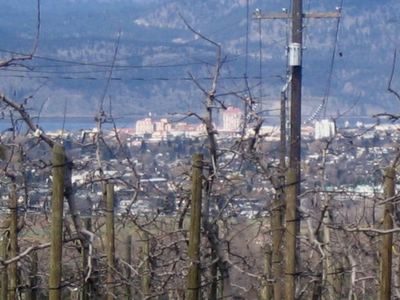
Grape vines growing in the ALR in Kelowna BC (April 2005)
BC is a beautiful province, as stated in feel good government paid ads prior to the May 17, 2005 election, its the best place on earth.
There is so much in this province, mountains, deserts, forests, lakes, rivers and an ocean. We even have some farm land. People from the rest of Canada may associate BC with Apples and wine, yet we grow raspberries, strawberries, peaches, cherries, cranberries and melons galore. Cattle is big business here too with two of the worlds largest ranches located in the Thompson and Cariboo regions. Organic farming is also a rapidly growing cottage industry.
BC's success in agriculture is not an accident and if the government in 1973 had not stepped in to protect the farmland we have, it is likely most of it would have succumbed to urban sprawl. Farmland like wilderness parks is vital. BC has some spectacular parks, which many across this country and around the world already know. In fact just over 12% of BC is park land, a figure no other North American jurisdiction can match. Like farmland, it is no accident this happened. BC in the 1990s made creating parks and protected areas a vital part of the government's mandate.
Agriculture in BC is a growing business. BCs wine industry uses hundreds of hectares to grow grapes. Fruit orchards are big business as well. BC is able to maintain a growing industry due to a commitment to prevent non-agricultural development on land that can support agriculture.
Much of our good farmland is located along river valleys and lakes. This of course is also where our settlements are. The Fraser Valley is among the richest farmland in Canada, sustaining a large agricultural base. The Okanagan supports Hundreds of orchards and scores of wineries. The interior has ginseng, cattle and other crops. The Peace country is grain country, an extention of the same terrain found in northern Alberta.
All of this and BC has only 1% available for agriculture. This fact hit the government in 1972 hard. At the same time the government was grappling with this fact, the land was being devoured by development. Speculators and farmers were able to get substantially more money selling their farmland for housing or other commercial use.
The government response came in 1973 with the BC's Land Commission Act (April 18). This Act prevented the use of agricultural land for anything other than agricultural. Reaction was swift from farmland owners. They argued they could not make enough farming and that they should be permitted to develop as they wished. The government won out and created the Agricultural Land Reserve and a commission to oversee its management.
Farmers and owners of farmland made defeating the government in the next election a priority. No one knows for sure as election financing in BC was still pretty much a open to those with money and farmers spent a lot supporting the Social Credit party in hopes they would repeal the BC Land Commission Act.
The Social Credit government did not repeal the act, and continued to enforce it. The government did however provide a few loop holes that many farmers were able to leap through. Some land was lost , but the integrity of the reserve was primarily left in tact.
Farmers continued to demand government support for the industry, given it was now limited to agriculture. The NDP government was preparing to bring in additional support programs for farmers when it was defeated in 1975.
The Social Credit government did bring in some support over the years, though no commitment to the industry was ever an established priority. In fact government support for agriculture has been a low priority for all governments in BC.
Today we face a new threat. Recent changes in the law by the BC Liberal government provide more loopholes allowing more land to be removed. I will have more on this threat to the less than 1% of BC that is good farmland in the days ahead. Developments in the Okanagan and Fraser Valley suggest the land reserve is about to shrink even more.
For more information on the new acts check below...
The Agricultural Land Commission Act, S.B.C. 2002, c. 36, was brought into force on November 1, 2002. This Act repealed the Agricultural Land Reserve Act, the Land Reserve Commission Act and the Soil Conservation Act, and replaced them with a new Act that incorporates some of the provisions from the repealed Acts, and established the Provincial Agricultural Land commission Act also amended the land use provisions of the Forest Land Reserve Act, but retains the forest land reserve designations and the authority of the commission to regulate
forest practices for private forest reserve lands.
and
On July 22, 2004, after consultation with the Union of BC Municipalities, government brought into effect the Agricultural Land Commission Amendment Act, S.B.C. 2004, c. 32 and associated amendments to the Agricultural Land Reserve Use, Subdivision and Procedure Regulation. These amendments provide new procedures for the filing of ALR applications with the Commission by First Nations, both pre-treaty and post-treaty. (Click here for key changes)

1 comment:
Does anyone know where designated ALC land can be viewed eg. Google Earth?
Currently, in light of what is happening to one MLA, I suppose it will continue to happen all over BC if the Commissioners don't read their manuals on what their responsibilities are to the public at large. We should be able to go to one place, one map to see how ALC land integrates with where we live.
We should be able to see the limits by which developers, and city halls, must abide by without breaking regulations eg. building multiple homes where only one may exist, or picker cabins being occupied family members only.
We should be able to see in one map, layers, ..........
Post a Comment